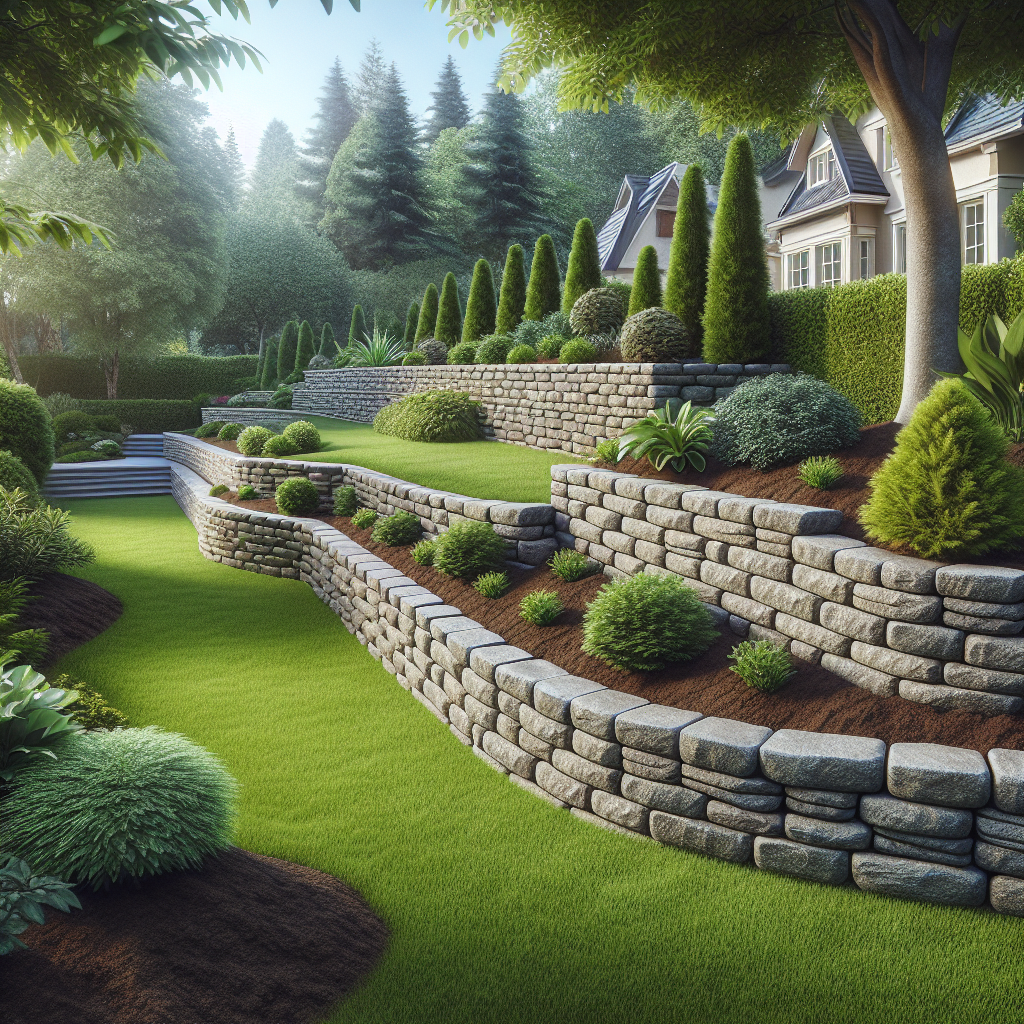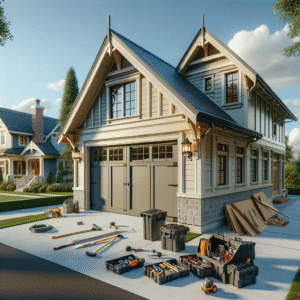When it comes to enhancing the functionality and aesthetics of your landscape, installing a retaining wall is a fantastic choice. This structure not only prevents soil erosion but also adds a structured beauty to any outdoor area. Whether you’re a DIY enthusiast ready to tackle your next big project or a homeowner planning to hire a professional, understanding the basics of retaining wall installation and maintenance is essential. From selecting the right materials to employing advanced construction techniques, this guide covers everything you need to know to ensure your retaining wall stands strong and looks great for years to come.
1. Understanding the Basics of Retaining Wall Installation
Choosing the Right Materials for Your Retaining Wall
Selecting the appropriate materials is crucial for the durability and effectiveness of your retaining wall. Options range from natural stones and concrete blocks to timber and poured concrete. Each material offers different aesthetic appeals and structural benefits, so consider your local climate and soil type when making your choice.
Step-by-Step Guide to Installing a Retaining Wall
Installing a retaining wall involves careful planning and execution. Start by mapping out the area, digging trenches, and laying a sturdy foundation. Proper alignment and stabilization are key, as is ensuring that each layer is level.
Common Mistakes to Avoid During Installation
Avoiding common pitfalls can be the difference between a successful project and a failing wall. Key mistakes to avoid include skimping on materials, poor drainage setup, and inadequate base preparation.
2. Essential Tips for Effective Retaining Wall Maintenance
Regular Inspection and Immediate Repair
To prolong the life of your retaining wall, conduct regular inspections to identify potential problems like cracks or bulges. Addressing issues early can prevent more significant damage.
Managing Drainage for Long-term Stability
Effective drainage is crucial to the stability of retaining walls. Ensure that water is directed away from the wall to prevent pressure build-up that can lead to structural failure.
Seasonal Maintenance Practices for Retaining Walls
Adjust your maintenance practices with the changing seasons — from clearing debris and vegetation to checking for freeze-thaw damage in colder months.
3. Advanced Techniques and Innovations in Retaining Wall Construction
Incorporating Geogrids for Enhanced Stability
Geogrids are synthetic materials used to reinforce soil behind the retaining wall. Their inclusion can significantly increase the wall’s stability and longevity.
The Role of Automation in Retaining Wall Construction
Automation is revolutionizing retaining wall construction, making processes faster and more cost-effective while ensuring precision and reducing human error.
Future Trends in Retaining Wall Materials and Design
The future of retaining wall construction looks promising, with advances in eco-friendly materials and aesthetically pleasing designs that blend seamlessly with natural landscapes.

If you’re ready to take your home improvement or construction project to the next level, we can help! Find trusted contractors on BuildNet, whether you’re looking for renovations, new builds, electrical work, plumbing, or anything in between. Our directory connects you with qualified professionals who can make your vision a reality.
Understanding the Basics of Retaining Wall Installation
Whether you’re a seasoned DIY enthusiast or a homeowner looking to enhance your landscape, installing a retaining wall can transform your outdoor space. Not only does it serve a functional purpose by preventing soil erosion, but it also adds aesthetic value to your property. Let’s dive into the essentials of choosing the right materials, the installation process, and the common pitfalls to avoid.
Choosing the Right Materials for Your Retaining Wall
When it comes to building a robust and durable retaining wall, selecting the right materials is crucial. Here’s a quick rundown of the most popular options:
- Concrete Blocks: Widely favored for their strength and versatility, concrete blocks are ideal for walls up to four feet tall.
- Stone Veneer: This gives a more natural look while providing durability. It’s perfect for achieving a rustic or classic appearance.
- Poured Concrete: If you’re aiming for a sleek, smooth finish and a high level of strength, poured concrete is a great choice.
- Timber: For a softer, more natural feel, timber can be a good option, though it may not last as long as stone or concrete.
Each material has its specifics regarding cost, durability, and installation difficulty, so choose one that aligns with your needs and local climate conditions.
Step-by-Step Guide to Installing a Retaining Wall
Roll up your sleeves—it’s time to build your retaining wall! Follow these steps to ensure a sturdy and effective structure:
- Plan Your Layout: Use stakes and string to mark the area where you want your wall. Make sure you check local building codes and any homeowner association regulations before you start digging.
- Prepare the Foundation: Dig a trench slightly wider than your wall and fill it with a base of gravel. This helps with drainage and provides a solid foundation.
- Lay the First Row: Place your base material (whether it’s blocks, wood, or another material) in the trench. Use a level to ensure each block is even and stable.
- Build Up: Stack additional layers of material, ensuring to stagger the joints for added strength. Use landscape adhesive for concrete blocks or stones to hold the layers together.
- Ensure Proper Drainage: Backfill the area behind the wall with gravel and install a perforated pipe directed away from the wall to prevent water pressure build-up.
- Finish with Topsoil and Landscaping: Once your wall is built, you can add topsoil and begin planting your garden, giving your new wall a beautiful and natural appearance.
Common Mistakes to Avoid During Installation
Even with careful planning, there are a few common errors you should watch out for:
- Ignoring Drainage: Proper drainage is vital to maintaining the integrity of your wall. Neglecting this step can lead to water pressure that may cause the wall to bulge or fail.
- Skimping on Materials: Opting for cheaper or lower quality materials can lead to problems down the road. Invest in quality to ensure your wall stands the test of time.
- Incorrect Base Preparation: A poorly prepared base can lead to settling and shifting. Make sure your base is compact and level.
- Overbuilding: Building a wall higher than necessary not only increases costs but can also pose safety risks. Stick to the planned height and consult professionals if unsure.
By understanding these basics and carefully preparing your project, you can build a retaining wall that is both functional and visually appealing. Remember, if the project gets overwhelming, it’s always a good idea to consult with a professional.

Essential Tips for Effective Retaining Wall Maintenance
Hey there! If you’ve got a retaining wall in your garden or yard, you know it’s not just about boosting your curb appeal—it’s a crucial structure that holds back soil and prevents erosion. But, like any other part of your home, it needs a bit of TLC to keep it standing strong. Let’s dive into some essential maintenance tips that will help ensure your retaining wall remains as sturdy as the day it was built.
Regular Inspection and Immediate Repair
First things first: keep an eye on your wall. Regular inspections can catch issues before they turn into big problems. Look out for cracks, signs of bulging, or sections of the wall that seem to be shifting. These can be indicators that your wall is under stress or has drainage issues.
When you spot a problem, don’t wait around. Immediate repair is key to preventing further damage. Small cracks might just need some caulking, while bigger issues might require professional help. It’s always a good idea to consult with a local contracting expert to get the right fix. Remember, a quick response can save you time and money in the long run.
Managing Drainage for Long-term Stability
Water is often the enemy when it comes to retaining walls. Proper drainage is not just a good practice; it’s essential for the longevity of your wall. Here’s how to manage it:
- Ensure good drainage behind the wall: Use backfill like gravel instead of soil, as gravel allows water to drain through quickly, reducing pressure on the wall.
- Install drainage pipes: This is especially important if your wall is holding back a significant amount of soil. Drainage pipes help channel water away from behind the wall, keeping pressure off and preventing waterlogging.
- Keep your gutters clean: This might seem off-topic, but clogged gutters can lead to water overflow, which can seep behind your retaining wall, causing problems. Regular gutter cleaning can prevent this.
Local contractors can help install the right drainage solutions for your specific situation, ensuring that your retaining wall stays as dry and stable as possible.
Seasonal Maintenance Practices for Retaining Walls
Each season brings its own challenges, so it’s important to tailor your maintenance routine accordingly:
Spring:
Spring is the perfect time for a thorough inspection after the harsh winter months. Look for any damage caused by frost-heave or water saturation. It’s also a great time to clean out any debris that has accumulated over winter.
Summer:
Summer might bring heavy rains depending on where you live. Keep an eye on the wall during these months for any signs of water pooling or erosion. It’s also a good time to ensure any plant growth near the wall isn’t causing damage with roots or trapped moisture.
Autumn:
As leaves fall, they can pile up and trap moisture, so keep the area around your retaining wall clear. Autumn is also a good time to check and prepare your drainage systems for the coming winter.
Winter:
Before the freeze sets in, ensure that water isn’t collecting anywhere near your wall as it can freeze and expand, causing cracks and heave. If you’re in a snowy area, be mindful of where snow is piled up during clearing as the extra weight can be stressful for the wall.
Maintaining a retaining wall is all about vigilance and prevention. With these tips, you’re well on your way to ensuring that your wall remains healthy and functional, adding beauty and value to your property while keeping your landscape safe and sound. Don’t forget to tap into local expertise by connecting with professionals who can provide personalized advice and services. Happy maintaining!
Advanced Techniques and Innovations in Retaining Wall Construction
When diving into the world of landscaping and outdoor design, retaining walls have always been a staple. However, as technology progresses, so do the methods and materials we use to construct these essential structures. Whether you’re a homeowner looking to enhance your property or a contractor keen on adopting the latest in construction tech, understanding these advanced techniques and innovations can significantly uplift your project.
Incorporating Geogrids for Enhanced Stability
One of the most significant advancements in retaining wall construction is the use of geogrids. Geogrids are a type of geosynthetic material made from polymers that are used to reinforce soil. They work wonders in retaining wall systems by providing additional stability and distributing load evenly, which is particularly useful in areas with soft soils or in walls that need to support heavy loads.
- How Geogrids Work: They are placed in between the layers of retaining walls during construction. As the wall is built up, the geogrids lock the soil in place, preventing it from shifting and increasing the overall mass and stability of the wall.
- Benefits: By enhancing the structural integrity, geogrids extend the lifespan of a retaining wall and reduce maintenance needs. They’re also environmentally friendly, as they are often made from recycled materials.
For contractors and DIY enthusiasts, incorporating geogrids isn’t just about improving the quality of the wall—it’s also a great selling point for clients concerned with longevity and sustainability.
The Role of Automation in Retaining Wall Construction
Automation is transforming various industries, and retaining wall construction is no exception. The integration of automated processes in the construction of retaining walls helps streamline operations, reduce labor costs, and enhance precision.
- Automated Machinery: Advanced machinery, such as automated block laying systems, can help in placing large retaining wall blocks with precision, speeding up the construction process and reducing human error.
- Software Tools: Design software helps in the planning and designing phase of retaining wall construction. These tools can simulate stress points and potential failure zones, allowing for adjustments before the physical construction begins.
Embracing automation doesn’t just make building retaining walls faster and less labor-intensive; it also ensures that every project meets high standards of quality and accuracy, making it a win-win for both contractors and clients.
Future Trends in Retaining Wall Materials and Design
As we look towards the future, the materials and design approaches used in retaining wall construction are evolving. Sustainability and aesthetics are becoming just as important as functionality and durability.
- Eco-Friendly Materials: Research is pushing towards more sustainable options, such as recycled plastic blocks or bio-based materials, which not only help reduce the environmental footprint but also offer new aesthetics and functionalities.
- Modular Designs: The future of retaining walls lies in modular systems that can be easily installed, replaced, or reconfigured. This flexibility allows for creativity in design and can cater to the specific needs of any landscape.
- Integrated Technology: Imagine retaining walls that can tell you when they need maintenance. Sensor technology could soon be integrated into retaining walls to monitor their condition and alert property owners to potential issues before they become serious problems.
Staying informed about these trends not only keeps your projects at the cutting edge but also ensures that they are sustainable and future-proof.
Whether you’re planning a new retaining wall project or looking to refine your construction skills, understanding and integrating these advanced techniques and innovations can significantly impact the success and sustainability of your work. Keeping an eye on these developments is essential for anyone in the construction and landscaping industries, as they promise to shape the future of how we design, build, and perceive retaining walls.

What are the best materials to use for a retaining wall?
Choosing the right materials for your retaining wall is crucial for both its functionality and longevity. Commonly used materials include concrete blocks, poured concrete, treated timbers, and natural stones. The choice depends on the project’s needs, aesthetic preferences, and budget. For example, concrete blocks are highly durable and offer a modern look, whereas natural stone adds a classic and unique aesthetic but can be more expensive.
Can you walk me through the steps of installing a retaining wall?
Installing a retaining wall involves several key steps:
- Planning: Assess the area, determine the wall’s purpose, and choose the right materials.
- Preparation: Clear the area, mark the layout, and prepare a solid foundation.
- Construction: Begin laying your materials from the base up, ensuring each layer is level and stable.
- Drainage: Install proper drainage behind the wall to prevent water pressure from building up.
- Finishing Touches: Backfill the area behind the wall and finish with landscaping.
What are common installation mistakes I should avoid?
Common installation mistakes include poor planning, inadequate foundation, ignoring drainage needs, and using the wrong materials. These can compromise the wall’s structure, leading to early failure or safety hazards. Make sure to thoroughly plan your project and consider consulting a professional if you are unsure.
How often should I inspect my retaining wall?
Regular inspections are key to maintaining a retaining wall. It is recommended to inspect your wall at least twice a year, ideally in spring and fall. Look for any signs of movement, cracking, or bulging, which could indicate issues with the structure or drainage problems.
What should I do if I notice damage to my retaining wall?
If you notice any damage, it’s important to address it immediately to prevent further deterioration. Small cracks might be repairable with filler or sealant, but more significant damage may require professional repair services.
How can I ensure proper drainage for my retaining wall?
Proper drainage is crucial for the longevity of a retaining wall. Ensure that there is a gravel drainage path or weep holes behind the wall to allow water to escape. Additionally, the landscape should be graded to divert water away from the wall.
Are there any specific maintenance practices I should follow depending on the season?
Yes, seasonal maintenance can vary:
- Spring: Check for winter damage and clear any debris that has accumulated.
- Summer: Ensure that your drainage systems are clear and functioning, especially if you live in a rainy area.
- Fall: Prepare for colder weather by checking the stability of the wall and clearing leaves and debris.
- Winter: Monitor snow and ice accumulation, and manage meltwater pathways.
How can geogrids enhance the stability of a retaining wall?
Geogrids are synthetic materials used to reinforce soil and enhance the stability of retaining walls. They are placed in layers between the soil and help distribute weight evenly, which is particularly useful in taller walls or in areas with soft soils.
What is the future of retaining wall construction?
The future of retaining wall construction looks promising with innovations like eco-friendly materials and automation in the construction process. New trends include the use of recycled materials and systems that integrate digital design tools, improving precision and efficiency.
Conclusion
In the world of DIY and professional home projects, constructing a retaining wall can be a substantial yet gratifying challenge. From choosing the right materials and installing them correctly to maintaining your wall through the seasons, every step is crucial for a structure that stands the test of time. Remember, regular check-ups and proper drainage play pivotal roles in the longevity of your wall.
If you’re planning a retaining wall project, don’t hesitate to seek expert advice to ensure your project’s success. Feel free to contact a contractor through the BuildNet website for a free quote. Their expertise can provide you with peace of mind and ensure that your retaining wall is both beautiful and durable.







